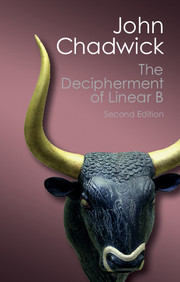1 - MICHAEL VENTRIS
Published online by Cambridge University Press: 05 June 2014
Summary
The urge to discover secrets is deeply ingrained in human nature; even the least curious mind is roused by the promise of sharing knowledge withheld from others. Some are fortunate enough to find a job which consists in the solution of mysteries, whether it be the physicist who tracks down a hitherto unknown nuclear particle or the policeman who detects a criminal. But most of us are driven to sublimate this urge by the solving of artificial puzzles devised for our entertainment. Detective stories or crossword puzzles cater for the majority; the solution of secret codes may be the hobby of a few. This is the story of the solving of a genuine mystery which had baffled experts for half a century.
In 1936 a fourteen-year-old schoolboy was among a party who visited Burlington House in London to see an exhibition organized to mark the fiftieth anniversary of the British School of Archaeology at Athens. They heard a lecture by the grand old man of Greek archaeology, Sir Arthur Evans; he told them of his discovery of a long forgotten civilization in the Greek island of Crete, and of the mysterious writing used by this fabulous people of prehistory. In that hour a seed was planted that was dramatically to bear fruit sixteen years later; for this boy was already keenly interested in ancient scripts and languages. At the age of seven he had bought and studied a German book on the Egyptian hieroglyphs.
- Type
- Chapter
- Information
- The Decipherment of Linear B , pp. 1 - 4Publisher: Cambridge University PressPrint publication year: 2014

